#i sure hope i get a good grade in coyle studies
Explore tagged Tumblr posts
Text
Let's talk about pre-Sinyala Coyle!!
Okay so, I’m really into character design, and I’ve noticed that a lot of people who draw pre-Sinyala Coyle tend to miss out some cool details about his Blackwell uniform. So, I figured I’d break it all down, covering 1950s fashion conventions, how Coyle blatantly ignores them, why he gets away with it, and some extra points about his overall dodgy behaviour. Because this post spiralled out of control.
Before we jump in, a quick note: Because of the comic’s style, there are definitely some inconsistencies, but I’ll do my best to piece things together. If you're into history, fashion, and Leland Coyle, stick around 🖤
First, some historical context.
Whether we like it or not, personal grooming and aesthetics have always played a big role in how we’re perceived. But in the 1950s, fashion wasn’t as focused on self-expression as it is today. Rather than standing out, most people aimed for conformity, with conservative ideals and public perception heavily influencing fashion choices. How someone dressed and presented themselves to the world immediately signalled their social status, character, and values. Maintaining a facade of respectability and adhering to social norms was a priority for most.
After World War II, being clean-shaven became a key part of a man's appearance. This was partly inspired by young men who had served in the military. Veterans accustomed to shaving daily carried the habit into civilian life. Of course, not everyone was clean-shaven, but facial hair was generally more common among older generations, as well as musicians, and actors, people who could flout convention without damaging their reputations.
By the mid-1950s, however, facial hair started making a bit of a comeback, thanks to cultural icons like Elvis Presley and Johnny Cash. Alternative hairstyles, especially those associated with greasers, weren’t widely accepted in professional settings. Instead, they became symbols of rebellion, linked to actors, outcasts, and those who rejected the status quo rather than conventional, well-to-do citizens.
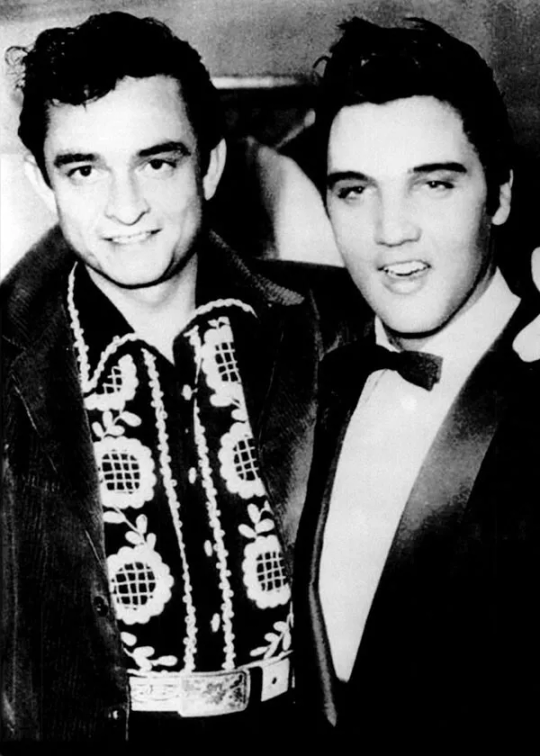
With that out of the way, let's talk about Coyle!
Thanks to the comics and in-game documents, we know that Coyle meets Clyde Perry in a Blackwell diner on February 16th 1956. Based on what we can piece together from his past, Coyle would have been around 33 years old at the time. Perry’s account of the altercation directly tells us that Coyle was well-liked and respected within his community.
Blackwell was (and perhaps still is) an extremely conservative town, where conformity to social norms would have been enforced through intense social pressure. The fear of negative judgment would have kept most people compliant. This makes Coyle’s deviation from 1950s conventions all the more apparent, though when we consider his past, things begin to make a bit more sense.
From both the comics and Coyle’s in-game dialogue, we know he had a troubled childhood (details to follow in a separate post). His adolescent delinquency eventually landed him in a military academy. However, his honourable service in the U.S. Marine Corps during World War II, combined with his undeniable charisma likely convinced most locals that he was a reformed man, paving the way for his position as a police sergeant.
His rough-around-the-edges persona may have only added to his charm, allowing him to get away with behaviour that might have otherwise raised eyebrows, such as openly flirting with a waitress or publicly beating a man senseless.
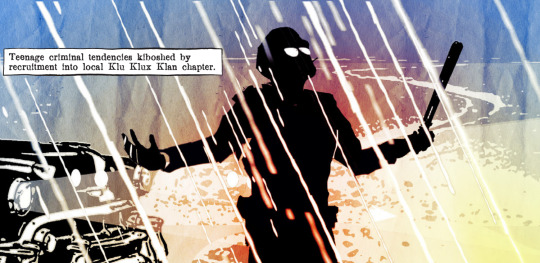
Although Coyle is primarily depicted as a silhouette in most full-body images, we can still piece together details of his uniform. Interestingly, his attire aligns more with a 1940s police officer than one from the mid-1950s. This could be a deliberate design choice to emphasize how both Coyle and the town he rules over are stuck in the past.
His uniform has a few key features:
Sam Browne belt – A leather belt with a supporting strap that runs over the shoulder and connects to a waist belt.
Standing collar & shoulder boards – Formal elements more common in earlier decades.
Shoes instead of boots – Just a note for the artists in the room.
Utility belt essentials – Includes a handgun, handcuffs, and a nightstick, which were standard for the time.
We get a clearer look at the general appearance of his uniform from some of the police cutouts in the Trials, though none of them feature a Sam Browne belt.
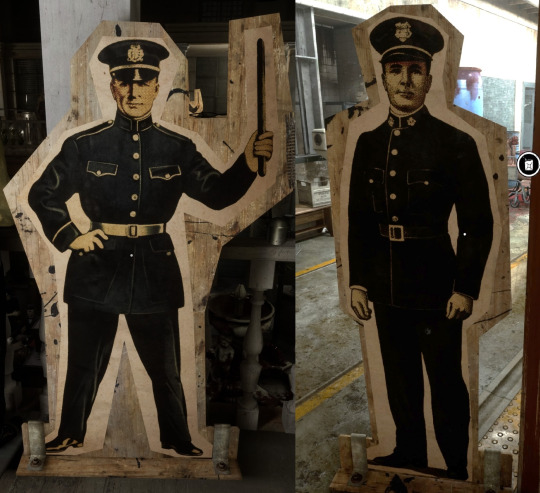
Coyle’s hair defies the social conventions of the time. It isn’t styled into any particular fashion and appears free of product, an unusual choice for a police officer, who would typically be expected to maintain a polished image, if not for personal pride, then at least for professionalism's sake. His hairline is noticeably receding, and it’s possible he combed it forward to disguise the thinning. By the time the events of the game take place, he’s completely bald, whether from stress-induced hair loss or simply shaving it once the recession became too obvious to hide. Pure speculation on my part.
His stubble, mussed hair, and unfastened top button suggest that when he meets Perry, he’s either finished work for the day or, at the very least, on his lunch break.
I found a few references of what I think Coyle's hair would look like because the comic is very bad at keeping it consistent. I went out of my way to find a guy with sideburns too. (Don't say I never do anything for you.) It's also worth noting that Julian Bailey, Coyle's VA had a receding hairline.

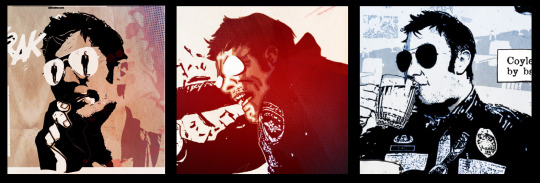

As a ‘respectable’ police sergeant, he should present himself as buttoned-up, clean, and tidy, proudly representing the Blackwell Police Department and setting a good example for his subordinates. Instead, everything about his presentation suggests a man who sees himself as above reproach, someone who enforces social conventions but doesn’t feel the need to follow them himself. In fact, one could argue he’s rewarded for breaking them, receiving positive attention from women despite (or perhaps because of) his disregard for propriety.
Coyle placing his hat on the waitress is a particularly bold move, especially given the strict dating conventions of the 1950s. Historically, a man placing his hat on a woman's head was a flirtatious gesture, a subtle but effective way of ‘claiming’ her, particularly in cowboy culture (Coyle’s parents were cattle ranchers, cowboy Coyle is canon).
In this context, it’s unlikely to be a genuine display of interest. More than anything, it’s a power play, a deliberate act of pushing the limits of propriety while asserting his dominance. The real impact comes when Perry walks in, seeing Coyle has already ‘marked his territory,’ immediately undermining Perry and ensuring he feels off-balance in the face of Coyle’s effortless machismo.
At the comic's conclusion, while Perry is driving away, injured but alive, he looks back to see Coyle standing outside the diner, wearing his police cap. At some point, he must have retrieved it from the waitress, likely with a charming, offhand apology for making a scene. Coyle doesn’t need to kill Perry to send a message, because letting him live IS the message. And Perry hears it loud and clear.
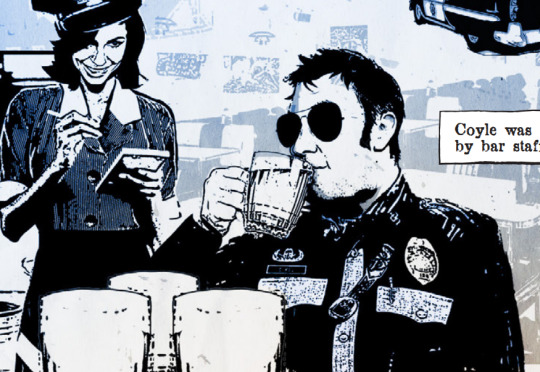
A quick side note, this isn’t so much about Coyle’s appearance, but rather his character.
When Oklahoma became a state in 1907, it adopted prohibition as part of its constitution, remaining a dry state up until 1959. Alcohol was largely banned, though moonshiners and speakeasies operated in secret, often with local law enforcement turning a blind eye. As a consequence, one of the only widely acceptable alcoholic beverages was “low-point beer” a drink containing just 3.2% alcohol, considered non-intoxicating under state law.
Perry states that Coyle ‘drank heavily’ before their encounter, but the fact that it was low-alcohol beer explains how he could be four pints down and still completely in control when it came to beating Perry.
It’s possible Coyle was pulling a deliberate ruse, letting Perry believe he was drunker than he actually was. If so, it wasn’t just about drinking, it was a test. Coyle may have wanted to see if Perry would try to take advantage of what seemed like a weakened opponent, only to prove that he was never at a disadvantage to begin with.
For a police officer to drink so openly in a conservative Christian town flies in the face of everything he’s supposed to uphold. Yet no one seems to care, or at least, no one dares to challenge him. Maybe it’s fear. Maybe it’s respect. Either way, Coyle knows exactly what he can get away with, and he enjoys every second of it.
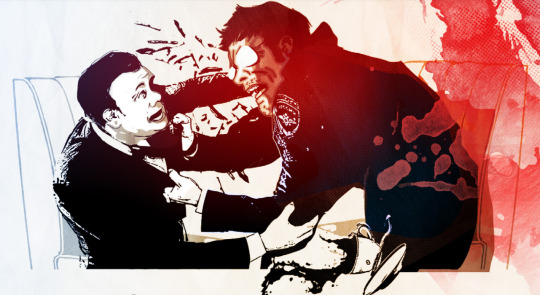
There are plenty of inconsistencies in the comic, and the art style doesn’t always make the details easy to see. Honestly, I could spend forever picking it apart and analyzing it, and one day, I probably will.
But in the meantime… I hope it's been informative. And I hope that some artists who draw pre-Sinyala Coyle will start depicting him in his Blackwell uniform. As much as I love a leather jacket, I’m a sucker for those military-style uniforms.
I hope you enjoyed this little dive into Coyle and his antics. Before I wrap up, I’m leaving you with a picture I annotated—it was meant to be the main image for this post, but... it’s awful. Apologies in advance if it hurts your eyes.
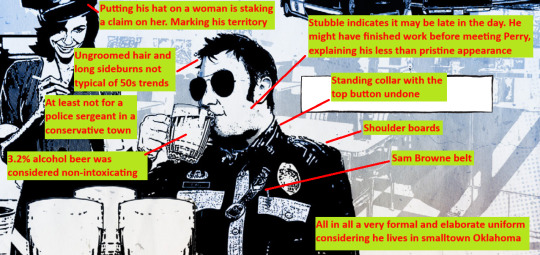
If you enjoyed my descent into madness, please inflict it upon your friends. I welcome friendly and constructive conversation in the comments. And hey, if you think I’m talking out of my arse, that’s your prerogative! This wasn’t meant as a critique, just the ramblings of someone who spends far too much time pondering the hows and whys of this man.
Well done if you made it this far, and thank you for reading!
As usual big shoutout to the Coyle Crew @misa-bun @decayinghost @soggy-bean for enabling me
#outlast trials#the outlast trials#leland coyle#outlast#sergeant leland coyle#officer coyle#sergeant coyle#not a shit post#i sure hope i get a good grade in coyle studies#something that is both normal to want and possible to achieve#I invented coyleology#long post#all my evidence is in the comic or the game#this is not a trust me bro situation
27 notes
·
View notes